Apr 11 (edited) • CPA’s Corner: Financial Q&A
How I Set Up My Self-Directed 401(k) (And Why You Might Want One Too)
Hey fam 👋
I wanted to drop a quick blog post that might be a game-changer for your future self. As both a CPA and a real estate agent, I’ve always looked for ways to legally grow wealth and protect it. One of the best tools I’ve found? A Self-Directed 401(k).
It sounds fancy (and maybe a little intimidating), but I promise it’s simpler than it looks — and it can open up a world of opportunities to invest your retirement dollars in the things you understand best… like real estate.
Let me walk you through how I set mine up, what it lets me do, and how you can get started too.
Step-by-Step: How I Opened My Self-Directed 401(k)
Here’s the quick breakdown of how I set mine up:
- Own an LLC or business ✅ You need to have some kind of self-employment income — in our case, real estate commissions work perfectly. My real estate LLC was already in place, so I was good to go.
2. Choose a 401(k) plan provider that allows self-direction✅ I went with The Entrust Group. They specialize in self-directed retirement accounts and offer Solo 401(k) plans with a lot of flexibility. Great service, super responsive.
3. Create your plan documents✅ This includes the plan adoption agreement, trust agreement, and some other legal docs that make your plan official and IRS-compliant. Your plan provider can provide these.
4. Get a new EIN (Employer Identification Number) for your 401(k)✅ You can’t use your business EIN for this — the 401(k) trust needs its own. You’ll apply for it via the IRS website. Takes just a few minutes.
5. Open a bank or brokerage account for the 401(k) trust✅ Once your plan and EIN are set up, you can open an account in the name of the 401(k) trust. From there, you can start contributing funds and investing.
Why I Love My Self-Directed 401(k)
Now here’s the fun part. With a self-directed 401(k), you’re no longer stuck picking between mutual funds A, B, or C.
You can invest in:
✅ Real estate (residential, commercial, land)
✅ Private lending (become the bank — offer loans to investors)
✅ Tax liens & deeds
✅ Private equity
✅ Life insurance policies (within certain rules)
✅ Even crypto or startups (if that’s your thing)
I’m all about control and diversification, and this plan gives me both. Instead of watching my retirement grow at 5-7% annually, I can invest in deals I personally source and believe in — often at double-digit returns.
And since I’m the trustee of my own plan (with Entrust as the third-party administrator), I have checkbook control. That means I can make investment decisions without waiting on anyone’s approval.
Pro CPA Tip 💡
There’s also a massive tax advantage here. As of 2025, you can contribute:
- Up to $23,000 as an employee (or $30,500 if you're 50+)
- Up to 25% of your business income as an employer (up to a $66,000 total cap)
That’s money you can deduct from your business income — reducing your taxes and growing your retirement account in investments you control.
Want Help Setting This Up?
If you’re part of this Skool community, I already know you're building something long-term. If you’ve got self-employment income (even part-time), you’re likely eligible to set up one of these plans too.
I’m happy to help walk you through it — just shoot me a DM or drop a comment inside the group. I’ll share my documents, vendor contacts, and help you avoid rookie mistakes.
Let’s get you set up to retire on your terms.
– Bracey Alexander, CPA | Real Estate Agent | Wealth Builder
4
2 comments

skool.com/theagentcompass
Welcome to The Agent Compass: your insider hub for intelligent real estate support. Come for the secrets, stay for AI training & investor intel.
Powered by
